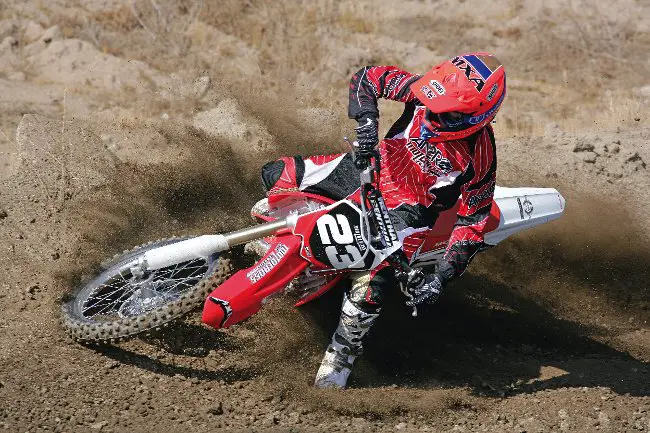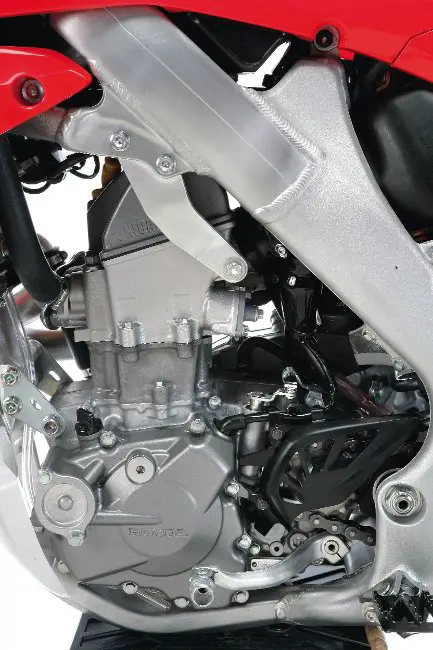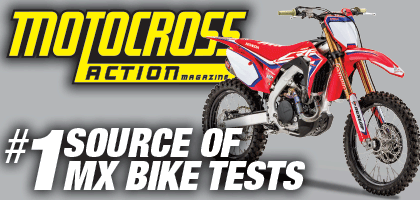REAL TESTS! 2010 MXA RACE TEST OF THE HONDA CRF250:

Q: FIRST AND FOREMOST, IS THE 2010 CRF250 BETTER THAN THE 2009 CRF250?
A: No. Last year, when we tested the Honda’s fuel-injected 2009 Honda CRF450, we were very clear to state that if we had to compare the 2008 CRF450 against the 2009 CRF450, the 2008 model would win. Guess what? Deja vu! Every MXA test rider preferred the 2009 Honda CRF250 over the 2010 CRF250.
Q: WHAT DID HONDA CHANGE ON THE 2010 CRF250?
A: Considering that the 2010 Honda CRF250 is totally new, there are changes a plenty.
(1) Programmable fuel injection. The worst-kept secret of 2010 was that the CRF250 would come equipped with electronic fuel injection (EFI). Surprise! The 2010 CRF250 has an EFI system. After struggling since 2006 with jetting issues caused by the oversize 40mm Keihin carburetor, Honda decided to kick carburetion altogether. Their hope? By using the technology off the 2009 CRF450 they could get rid of the bog. For 2010, the CRF250 receives a 50mm throttle body with a 12-hole injector fed by a 50 psi pump. Thanks to the large AC generator (6.5 amps at 5000 rpm) starting also became easier (regardless of whether the bike was hot or cold).
(2) Frame. The frame Honda designed for the 2010 CRF250 isn’t all new. Say what? Most of it’s concepts are borrowed from the 2009 CRF450 (if not in parts, then in spirit). The top half of the frame on the CRF250 is a carbon copy of the CRF450. The lower frame cradles, lower engine mounts and upper frame casting (the casting that joins the upper motor mounts to the down tube) are different because of the smaller engine. The CRF250 retains the same progressive steering damper that has been in production since 2008, but the damping spec is slightly more aggressive.
(3) Engine. The 2010 CRF250 powerplant received several major changes. First, Honda lengthened the stroke for greater top-end power and used a 13.2:1 high-compression piston. The piston’s top thickness has been reduced, while the crankshaft center is 10mm lower to accommodate the horizontal position of the crankcase reed valve (it was positioned vertically in 2009). This change allowed Honda’s engineers to make the engine more compact for a lower center of gravity. The cylinder angle has also been tilted five degrees back to improve centralization of mass. Second, Honda stuck with their Unicam design, which they believe has a lower center of gravity and less parts than the competition. The valve springs are longer and the cam timing is new (for added durability). The valve spring material has been changed to a stronger alloy steel. The new shape and balance of the crank changes the angle of inertia and is lighter for better traction and acceleration. Third, radiator cooling capacity has been increased from 14.6 kW (2009) to 14.7 kW (2010). The actual size difference between the two radiators is minimal. Most of the cooling capacity increase is due to the design of the radiators. The liquid capacity has been increased from 1.06 quarts to 1.16 quarts.
(4) Suspension. The CRF250 will once again come equipped with Showa suspension, but the forks and shock are completely new. The forks are now 48mm (they were 47mm in previous years). Fork diameter is claimed to have been increased to improve the rigidity of the forks, but, in truth, they were most likely upsized so that Honda could use the same triple clamps from the 48mm Kayaba-equipped CRF450. The tubing change required larger diameter pistons for more progressive valving. The shock has the same style piggyback reservoir as the CRF450, and the new internals improve initial harshness and offer more midrange control. The position of the shock has been moved lower and further forward in the frame to improve handling.

Score card: The single most important aspect of any 250cc four-stroke is the power. Next comes handling and finally suspension. We give the 2010 Honda CRF250 a B+ on its powerband, C- on its handling and B- on its suspension setup.
(6) Transmission. The gearing and ratios have been changed to match the new engine character and improve acceleration. The 2009 model had 13/51 gearing. The 2010 model has 13/48 gearing. That’s tall!
(7) Exhaust. Gone is the twin-pipe muffler system. In its place is an all-new single muffler that is a spitting image of the CRF450 can. The main difference? The CRF250 muffler doesn’t contain a resonance chamber in the front of the canister (even though it looks like it does). The muffler is shorter and lower in the frame (for better centralization of mass) and weighs 0.78 pounds less than the twin-pipe system. The updated subframe and rear shock reservoir also ensure better exhaust routing.
(8) Gas tank. The new gas tank not only accepts a fuel pump for the EFI system, but the overall shape has been changed. More compact, the new tank has a 1.5-gallon fuel capacity (down from a 1.9-gallon capacity in 2009). The air intake system has a velocity stack design for increased airflow. The airbox opening is also larger for easier access when changing the air filter.
(9) Body styling. The CRF250 receives an aesthetic face lift. Borrowing the exact same plastic and seat from the CRF450, the 2010 CRF250 has a newly designed front fender, front number plate, shrouds, side panels, rear fender, mud guard and seat.
Q: WHAT DO ALL OF THESE CHANGES ADD UP TO?
A: Face it, the single most important aspect of any 250cc four-stroke is the power. Next comes handling and finally suspension. We give the 2010 Honda CRF250 a B+ on its powerband, C- on its handling and B- on its suspension setup.
Considering that the 2010 Honda CRF250 is all-new, the bike is a whole different ball of wax from the 2009 model. Testing the 2010 Honda CRF250 gave us flashbacks to testing the 2009 Honda CRF450. Virtually every trait that the CRF450 had, good or bad, was on display on the 2010 CRF250. At the outset, Honda’s goal was to improve power, reduce mid-stroke harshness in the forks, and create a more nimble handling package. They weren’t totally successful.
Q: DOES THE 2010 CRF250 HAVE JETTING ISSUES?
A: That’s a trick question! The 2010 CRF250 is electronically fuel injected. With EFI onboard, Honda has finally solved their bogging issues. Good riddance 40mm Keihin!

Reborn: The 2010 engine is totally new from the cases up.
Q: IS THE 2010 CRF250 FASTER THAN THE 2009 MODEL?
A: If Honda had stuck with the same engine that they had in 2009, we would be loving the 2010 CRF250. Why? Every MXA test rider raved about the 2009 engine. It had the strongest and widest powerband of any 250 four-stroke in 2009.
There is always danger in going for the gusto, and Honda’s engineers swung for the fences with a new stroke, piston, crankshaft, cylinder angle, valve springs, cam timing and fuel delivery system.
Every single test rider felt that the 2010 CRF250 lacked the hit and snap of the 2009 model. The new engine is still fast, largely in the midrange, but it doesn’t have the berm-blasting output, seamless flow or vivacious personality of last year’s bike.
The 2010 CRF250 is an effective engine for racing, but it’s not as fun to ride as last year’s engine. If you live and die in the midrange, then you’ll love the new CRF250 engine.
Q: WHAT DO WE THINK OF THE FUEL INJECTION ON THE 2010 CRF250?
A: We can’t help but like that it banishes the bog, but we have to assume that the EFI also banished the bark from the hound dog. Although the old Keihin carb was far too big for the CRF250, it still managed to hit hard, pull with authority and cover an incredible rpm range. The bog was only an issue until you figured out the jetting?and we figured that out years ago. The EFI bike has decent power in the middle, but it lacks low-end throttle response or high rpm pull. We must admit that when the bike is sitting on the stand, it sounds snappy.
Q: HOW DOES THE CRF250 ENGINE RUN ON THE DYNO?
A: Would you be surprised to learn that the 2010 CRF250 practically mirrors the 2009 model on the dyno, despite our opinion that the two engines are totally different? In our opinion, the 2010 engine is never stronger than the 2009 engine at any point on the rpm curve. The only real difference between the two bikes on the dyno is that the 2010 powerplant flattens out at 11,000 rpm while the 2009 engine shows signs of life through 12,300 rpm. On the dyno, the 2010 CRF250 reaches 36.37 horsepower at 10,400 rpm with maximum torque of 19.18 foot-pounds. For comparison, the 2009 CRF250 reached 37.02 horsepower at 10,500 rpm with maximum torque of 19.28 foot-pounds. Last year’s Honda is stronger, but the horsepower difference is nothing to write home about.
Q: DOES THE 2010 HONDA CRF250 WEIGH LESS THAN THE 2009 MODEL?
A: Yes. It is one pound lighter than the 2009 CRF250. Where did they trim excess fat? The biggest weight saver is the single-sided muffler (0.78 pounds lighter). The frame and cylinder head are also lighter. We commend Honda for dropping weight off their already light CRF250.
Q: HOW GOOD IS THE STOCK GEARING?
A: Thanks to the midrange powerband we didn’t have any gearing issues. We’re happy to report that you shouldn’t need to invest in different teeth sprockets for the 2010 CRF250.
Q: HOW GOOD IS THE 2010 HONDA CRF250 SUSPENSION?

Geometry: The offset was changed from 22mm to 20mm.
If Honda had stuck with the 2009 chassis we would be inclined to believe that the new 48mm Showa forks and shock would be an improvement. Together they would work well on the old chassis, but they don’t do the trick on the 2010 CRF250. The forks are undersprung and the shock sits high in the rear, creating a stinkbug stance.
A: We made several major changes to help remedy the excessive headshake and improve the handling.
(1) We added stiffer fork springs to help the forks stay up in their stroke.
Spring rate: 0.46 kg/mm (0.45 kg/mm stock)
Oil quantity: 342cc
Compression: 8 clicks out (13 clicks out stock)
Rebound: 8 clicks out
HPSD: 4 clicks out (7 clicks out stock)
Fork leg height: Flush with top clamp
Notes: The 48mm Showa forks come with a separate aluminum screw on top of the fork legs. Don’t use it to bleed air out of the forks! It is only to be unscrewed when the forks are being serviced. Use the brass screw to bleed air out of the fork legs. We believe that any rider over 150 pounds would benefit from stiffer fork springs.
Q: WHAT WAS OUR BEST SHOCK SETTING?
A: Here is what the MXA wrecking crew ran in its 2010 CRF250 (stock settings are in parentheses):
Spring rate: 5.3 kg/mm
Race sag: 105mm
Hi-compression: 1-1/16 turns out
Lo-compression: 7 clicks out
Rebound: 10 clicks out (11 clicks out stock)
Notes: The shock is very sensitive to high-speed compression. Heavier riders should go in 1/4 turn on high-speed compression and set the sag at 100mm.
Q: HOW DOES THE 2010 CRF250 HANDLE?
A: The bike handles like a 2009 Honda CRF450. We aren’t ecstatic about the similarity. Why? Test riders complained endlessly about the stinkbug stance, soft forks, head shake and oversteer on the CRF450, and since the two frames share the same geometry DNA, they handle practically the same.
The CRF250’s 27.15-degree head angle reacts like it is steeper than its number suggests! Last year the CRF250 has a slacker 27.90 head angle and the trail was decreased for 2010 from 125mm to 116mm. You don’t need a degree in plasma physics to know that the 2010 Honda is going to handle quicker than the 2009 model. The numbers tell the tale. The new geometry is busy…very busy. It is steep enough that the the forks must fight against bottoming, especially under a heavy load (landing from jumps, hard braking or pounding through braking bumps). There is a major tendency to oversteer because of the weight shift forward. Additionally, the rear of the bike sits high, and the uneven weight distribution on the front-end creates headshake. Down relatively fast straights in third gear we held on to the handlebars and said a dozen Hail Marys.
The head angle is guaranteed to yield sharper turning and it does, but too much of a good thing isn’t a good thing. The combination of moving the front wheel 15mm closer to the engine, the steeper head angle, decrease in trail, softer forks and stinkbug rear end create a knifing sensation through corners.
We are confident that we can calm it all down in time (and with the judicious application of cubic dollars). To the extent that the suspension setup is to blame, that can all be ironed out.
Q: WHAT DID WE HATE?
A: The hate list:
(1) Frame. This was a busy bike. It shook like a third-grader on a Butterfinger binge.
(2) Forks. Last year the CRF250 forks suffered from mid-stroke harshness. For 2010, the harshness is gone and has been replaced by soft fork springs.
(3) Clutch. We burned through the CRF250 clutch in six hours. Honda lengthened and added more coils to the clutch springs. These changes provide a better clutch feel, but don’t create enough grip. Stiffer clutch springs are in order (last year’s clutch springs will not work as a replacement, as they are too short).
(4) Front tire. The day we no longer see a Dunlop D742FA on a production bike will be a great day. No front tire would be better than a 742.
(5) Footpegs. Dear Honda, Hodaka called. They want their footpegs back. The CRF250 footpegs are the worst in the class.
(6) Front brake guard. In 2009, Honda began using a front brake guard with the axle spacer molded into the plastic. We believe that the huge plastic brake guard hinders airflow to the rotor, causing the front brake to overheat. We remove the brake guard by pressing the spacer out on a press.
(7) Mud guard. The new mud guard does its job of protecting the shock from harmful roost, but the chain gnaws it away in the process.
Q: WHAT DID WE LIKE?
A: The like list:
(1) Electronic fuel injection. Historically number one on our list of CRF250 complaints, jetting is no longer a problem.
(2) Engine. The 2010 CRF250 engine isn’t as snappy as last year’s, but we do respect its midrange performance. It is raceable in stock trim.
(3) Sound. Au revoir, twice pipes. The new single muffler is 3/4 of a pound lighter, cheaper to replace, and has a moderately quiet 96.5 dB output (which is not AMA legal).
(4) HPSD. Never before has the CRF250 needed a progressive steering damper more than the 2010 model. We’re happy to see the 22-click adjustable damper since it helps reduce headshake.
(5) Aesthetics. We like the new look of the CRF250. We also like that plastics are interchangeable between the CRF250 and CRF450.
(6) Shock body. Showa decreased the size of their shock body for better exhaust clearance. The smaller and fatter shock body is further away from the blazing-hot midpipe.
Q: WHAT DO WE REALLY THINK?
A: It may not be polite to say that we miss the 2009 Honda CRF250, but we do. We appreciate Honda’s ingenuity on the 2010 CRF250, but the previous CRF250 was a proven and refined package. The 2010 CRF250 isn’t a bad bike, but we’d be lying if we said that it was the best bike made.






Comments are closed.